Page Two
"Graphic chill appeal!" —Hollywood
Reporter
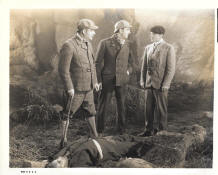
Holmes meets Stapleton |
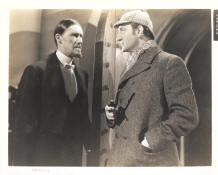
Holmes tells Barryman about the death of the convict. |
"Slated to set a new high among chillers!"
—Boxoffice
THE HOUND OF THE BASKERVILLES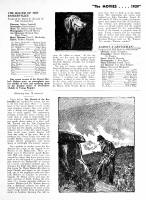 Twice before
The Hound of the Baskervilles has reached the screen, but this is
the first time since 1922 — a
curious lapse in the movie history of one of the most gripping
mystery tales ever written with a strong and popular central
character to assure appeal. the explanation, perhaps, is that the
story, running perilously close to what is fantastically ludicrous
instead of dramatically credible, is not worth doing unless it is
done well. Mr. Zanuck and the 20th Century-Fox technicians have done
it well. Their picture has not the steady, accelerating, cumulative
terror of the film which imagination insists some master director
will some day make of the story. But it reproduces the Conan Doyle
tale with admirable fidelity, creates and maintains the proper
shivery atmosphere and moves along in forthright film-mystery
manner.
As a prelude to modern times the film sketches the origin of the
legend of the Hound of the Baskervilles. There on a bleak moor in
Devonshire stands Baskerville Hall and strange events have convinced
the natives that there may be some truth in the old legend of a
ghostly hound that destroys the Baskervilles in revenge for a crime
committed centuries ago. So strong is the belief that when word
comes that young Sir Henry Baskerville plans to leave Canada and
return to the ancestral hall, one of the neighbors seeks our
Sherlock Holmes in London to prevent a tragedy. Sir Henry arrives
and stays despite warnings of death, finding the stepsister of a
strange naturalist sufficient incentive. Holmes and Dr. Watson
discover that a diabolical schemer has taken advantage of the legend
to let loose on the moor a huge hound. They announce their return to
London, knowing this will inspire the villain to action. As the fog
drifts over the moor, the hound pursues Sir Henry
— and in the chilling climax
Sherlock Holmes unmasks the murderer and his motive.
No one, of course, could ever match Sherlock Holmes as he exists
in the minds of his admirers, but Basil Rathbone is as true a choice
as the movie roster could offer. Nigel Bruce is dr. Watson to
perfection, a complete and credible characterization, inclined to
steal all his scenes by the sheer solid sincerity of his
performance. Richard Greene is an adequate Sir Henry, while Wendy
Barrie is rarely more than nice to look at as his sweetheart. The
supporting cast carries such stalwarts as John Carradine, Lionel
Atwill and E.E. Clive to create good atmosphere and supply brief
bits of excellence. The settings and photography conjure scenes of
ghostly impact and the musical score, punctuated by the
spine-chilling howls of the hound, is properly eerie in tone. Young
romance and an occasional flash of humor find their place, but are
subordinate to the grim business which Sherlock Holmes sums for Dr.
Watson: "It's murder, Watson, murder!"
—The Movies ... and the People Who Make Them, 1939 |
"Opened to plaudits of a packed house!" —New
York Daily Mirror
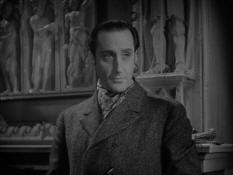
Holmes notices the portrait of Sir Hugo Baskerville |
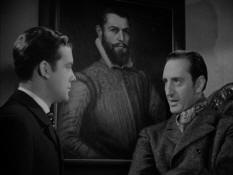
Holmes admires the portrait of Sir Hugo. |
"Class mystery thriller! Conveys unrelenting menace!"
—Los Angeles Times
The Hound of the Baskervilles
Sherlock Holmes Lives AgainThis is a quite direct
picturization of the Sir Arthur Conan Doyle story of the same name.
Basil Rathbone portrays the great Sherlock Holmes in completely
satisfactory manner and Nigel Bruce's performance as the faithful
Dr. Watson is straight from the Doyle text. The film is so precisely
the book, in substance, tone and spirit, that the obvious
exploitation cur is for a straight campaign addressed to the
millions who have read it and such other millions as may not have
got around to reading it but have meant to some time, and now, under
the circumstances, needn't.
The Doyle technique for creating an atmosphere of gloom, mystery
and suspense is duplicated by Ernest Pascal's play, by Sidney
Lanfield's direction and by the performances of Lionel Atwill, John
Carradine, Nigel de Brulier and Beryl Mercer, the principals chiefly
charged with creating audience apprehension. Richard Greene and
Wendy Barrie take care of the romantic side of the story, given more
prominence than in the printed original but still secondary.
The well remembered story is about a hound, rumored to be
something of a phantom, which roams the moor in savage hostility to
the successive masters of the House of Baskerville. Friends of the
family bring the matter to the attention of the famous
criminologist, who solves the mystery by a process of hypothetical
deduction, personal investigation and, of course, disguise.
Mr. Rathbone's enactment of the Holmes role is a business-like
job. He looks the part and talks it. He plays the fiddle once or
twice, briefly, but he does not resort to the needle for
inspiration, surcease or other reason during the picture. First, and
last, reference to it comes in the final line of dialogue when,
leaving the Baskerville drawing room for his chambers after
announcing himself fatigued by his exertion, he calls back to his
associate, "Watson—the needle." Dr.
Watson picks up his medicine case and follows him out of the
picture.
Gene Markey is down as associate
producer of the film.
—Motion Picture Herald,
April 1, 1939 |
"A thoroughly entertaining mystery!" —New
York Journal-American
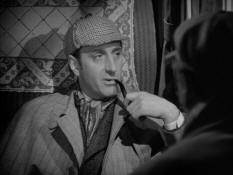
On the train, Holmes explains,
"We're just giving the impression of rushing up to London." |
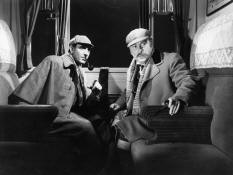
Holmes and Watson get off the train at the next stop. |
"Best of Sir Arthur Conan Doyle films!" —New
York World-Telegram
"The Hound of the Baskervilles"
IMPRESSIVE PRODUCTION OF FAMOUS SHERLOCK HOLMES THRILLER SPLENDIDLY
ACTED.
A really impressive achievement in bringing the famous Conan
Doyle spine-chiller to the screen, the story wherein the [?] and
ferocious hound bounds over the bleak English moor in Devonshire to
perpetrate its ghastly work. Perhaps no other detective murder
thriller has been so widely read in this country, so it should prove
easy for the exhibitor to get them in, especially with the
distinguished cast that play the principal roles. Richard Greene has
the part of Sir Henry Baskerville, the heir to the ancestral Hall on
the forbidding moor, who comes from Canada to open the place after
the mysterious death of his uncle. Lionel Atwill as Dr. Mortimer
suspects that murder has been done, and that other crimes will be
perpetrated, so he sends for Sherlock Holmes to come from London.
The part of the great sleuth is impressively handled by Basil
Rathbone. His friend and companion, the famous Dr. Watson, is in the
hands of Nigel Bruce. The thriller works up to the celebrated scene
on the moor the night of the attempted murder of the heir to the
Baskerville estate by the loosing of the vicious hound. Sherlock
Holmes practically stages the setting for the attempted murder, for
that is the only way he can get the evidence to prove who the
criminal is. The moor in the fog with the moon shining through, the
onrushing figure of the great hound, baying bloodcurdlingly, has
been thrillingly staged, and will send delightful shivers along the
spine of any normal person. Of course Holmes and Watson are on hand
to kill the brute and save the intended victim. Later at the Hall
they expose the murderer, who had attempted to do away with the
great detective a few minutes before by locking him in the dead
hound's prison box. Exceptionally fine performances by a practically
all-English cast, in keeping with the story. Selling angles: The
famous Sherlock Holmes thriller come to the screen with a great
English cast.
DIRECTION, Very Good. PHOTOGRAPHY, Excellent.
—The
Film Daily, March 27, 1939 |
"Enough to give Roxy customers a swell set of jitters!"
—New York Evening Post
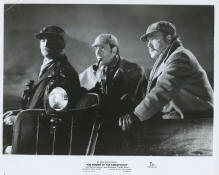
Holmes and Watson hurry back to Baskerville Hall |
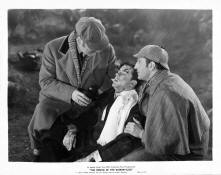
Holmes and Watson reach Sir Henry just in time to save
him. |
"Sent many a shudder through last night's audience!"
—Los Angeles Examiner
"Hound of the Baskervilles" Standard
Thriller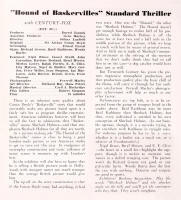 There is an inherent eerie quality about Conan
Doyle's "Baskerville" story that would inevitably make any picture
based upon it a fairly safe bet as program thriller entertainment.
American exhibitors however, will have to sell the fact to
adolescents that "Baskervilles" means Sherlock Holmes—and
then emphasize Sherlock Holmes for all they are worth.
As a picture making job "The Hound
of the Baskervilles" comes as close to being a good London-made
picture as any American studio is apt to turn out this year. In
stodginess of screenplay construction and static talkiness of many
scenes it measures up with London's best.
So the exhibitor will also have to
figure that he is selling a British picture made in Hollywood, with
marquee names not much stronger than the average British picture
would give him.
The tip-off on the story
construction is that if the Conan Doyle story had anything, it had
two stars. One was the "Hound," the other was "Sherlock Holmes." The
Hound doesn't get enough footage to realize half of his
possibilities, while Sherlock Holmes is off the scene for at least
two and a half reels in the middle portion of the picture, while we
keep in touch with him by means of printed inserts. And so little
use is made of Sherlock's immortal astuteness in the solving of the
mystery that we don't really think they had to call him in on the
case—a dog catcher would have done just as well.
But Twentieth Century has given the
picture impressive atmospheric production, and that production
quality plus the basil chill of the theme, will carry it through for
fair audience satisfaction. Peveral Marley's photographic
achievement will help as much as any other factor.
Performances are top hole, as is to
be expected from the group of troupers listed in the credits. Basil
Rathbone may be more Basil Rathbone than Sherlock Holmes, but then,
every individual is entitled to his own conception of Sherlock
Holmes (In our humble opinion, though it is a mistake trying to get
anywhere with Rathbone in straight roles. For audience purposes he
has to be a rat—whether it is a butler rat, a royal rat, or a
relative of Frankenstein's.)
Nigel Bruce, Beryl Mercer, and E.E.
Clive—the latter in a small bit—highlight the support, though it is
unfair to mention any names in a skilful trouping cast. The picture
won't do Richard Greene any good, or any particular harm. Wendy
Barrie does the best she can with nothing. Director and scripter are
good in spurts.
Exhibitors' Booking Suggestion:
Play the words "Sherlock Holmes" and the shocker angle on the title
and you'll get the customers who buy that. They won't complain.
—Box Office Digest, March 27, 1939 |
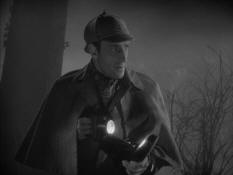
Holmes tracks the hound to its lair. |
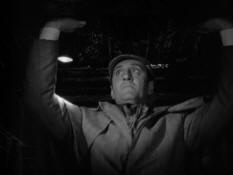
Holmes is trapped in the Hound's lair. |
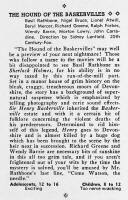 "The Hound of the Baskervilles" "The Hound of the Baskervilles"
"The Hound of the Baskervilles" may well be a preview of your next
nightmare! Those who follow a name to the movies will be a bit
disappointed to see Basil Rathbone as Sherlock Holmes, for
his ability is in no way taxed by this run-of-the-mill part.
Set in a manor house of grim history on the bleak, craggy,
treacherous moors of Devonshire, the story has a background of
supernatural suspense which is emphasized by telling photography and
eerie sound effect. Sir Henry Baskerville inherited the
Baskerville estate and with it a certain bit of folklore
concerning the violent deaths of his predecessors. Determined to rid
himself of this legend, Henry goes to Devonshire and is
almost killed by a huge dog which has been brought to the scene by
the heir next in succession. Richard Greene and Wendy Barrie are
necessary bits of sunshine in this all too grim tale, and if you
aren't frightened out of your wits by the time the mystery is
solved, you'll be amused by Mr. Rathbone's last line, "Come Watson,
the needle."
Adolescents, 12 to 16
Exciting |
Children, 8 to 12
Too nerve wracking |
—Motion Picture Reviews, April 1939 |
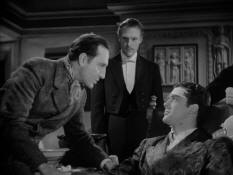
Holmes arrives at Baskerville Hall in time to prevent another death. |
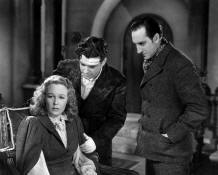
Beryl Stapleton is shocked to learn that her brother is the murderer. |
Page 3: posters, lobby cards and promo photos
Back to Page 1 of The Hound of the Baskervilles.
Back
to Sherlock Holmes films
|






















